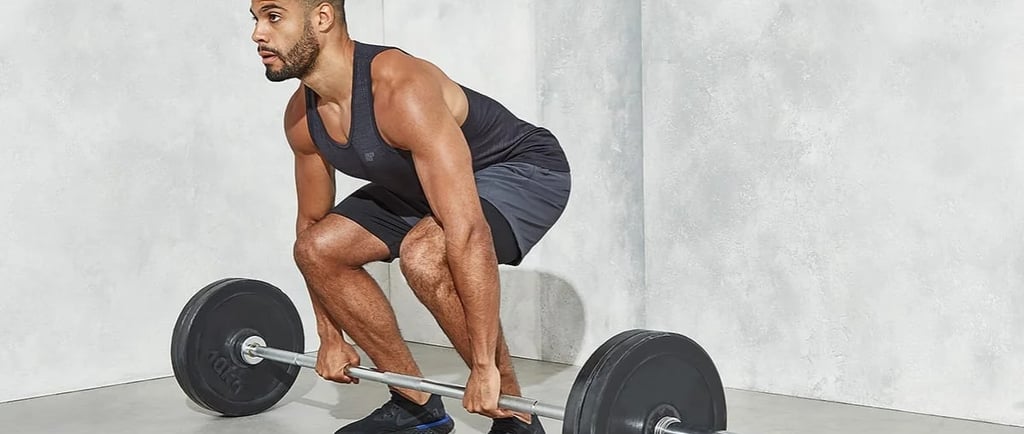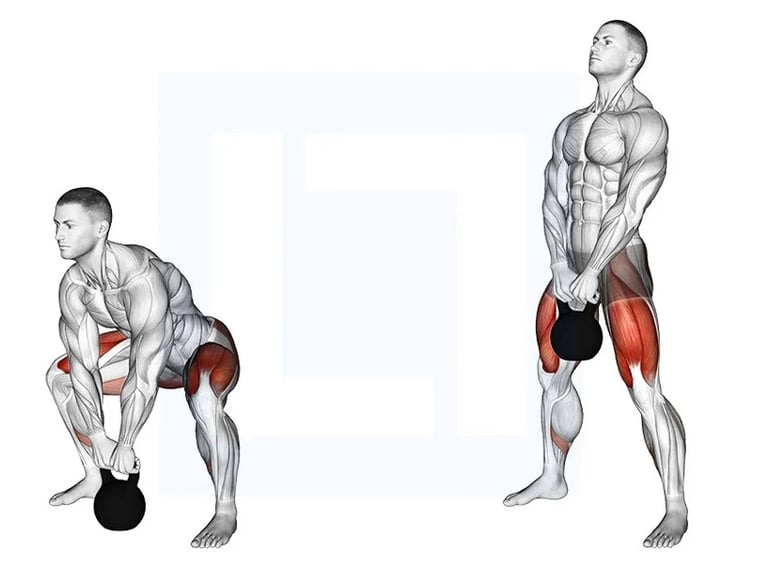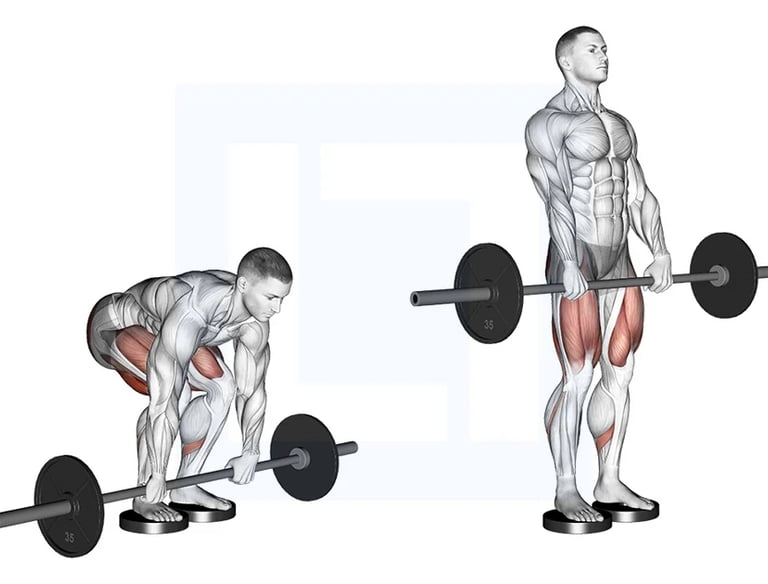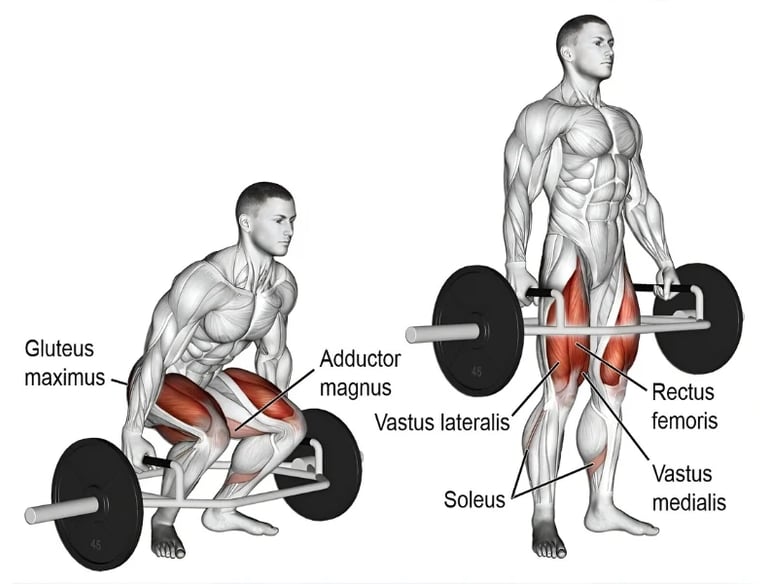Exploring Deadlift Variations: Benefits, Sets, and Key Techniques
GYM WORKOUT MODULES
9/23/20255 min read


Introduction to Deadlifts
The deadlift is widely regarded as a fundamental exercise in strength training, revered for its direct impact on overall fitness and athletic performance. This compound movement primarily targets several major muscle groups, including the glutes, hamstrings, lower back, and core, contributing to both muscle strengthening and hypertrophy. By engaging multiple joints and muscle systems simultaneously, the deadlift provides a comprehensive workout that enhances strength and stability across various movements.
In addition to its muscle-building benefits, the deadlift plays a crucial role in improving posture. As individuals learn to execute the lift correctly, they develop the ability to maintain proper spinal alignment and stability, bolstering core strength. This is especially important in today's sedentary lifestyles, where prolonged sitting can lead to muscle imbalances and poor posture. Deadlifting not only mitigates these issues but also enhances functional movement patterns, making everyday activities easier and safer.
The evolution of the deadlift dates back to ancient lifting practices, gradually transforming into one of the most essential exercises in contemporary strength training regimens. Its versatility has led to the development of various deadlift variations, each catering to specific fitness goals. Whether aiming for explosive strength, muscle endurance, or overall conditioning, the deadlift remains a centerpiece of strength programs worldwide.
For gym-goers, incorporating deadlifts into their routines is indispensable. Whether performed with barbells, kettlebells, or bodyweight, deadlifts help promote not only muscle growth but also functional strength crucial for athletes. Thus, understanding the underlying mechanics and benefits of deadlifts is fundamental to anyone seeking to enhance their fitness journey.
Popular Deadlift Variations
The deadlift, a fundamental exercise for strength training, comes in several variations, each offering unique benefits and targeting different muscle groups. Among the most recognized variations are the conventional deadlift, sumo deadlift, Romanian deadlift, and trap bar deadlift. Understanding these differences is essential for selecting the appropriate form to meet specific fitness goals.
The conventional deadlift is often considered the classic approach, where the lifter stands shoulder-width apart and pulls the barbell from the ground. This variation predominantly targets the posterior chain, including the glutes, hamstrings, and lower back. Mastery of the conventional deadlift helps in developing overall strength and stability.
In contrast, the sumo deadlift features a wider stance, with the feet positioned outside shoulder-width. The grip is inside the knees, which shifts the emphasis toward the quadriceps and inner thigh muscles. This variation is particularly beneficial for those with limited hip mobility or individuals seeking to reduce lower back strain.
The Romanian deadlift, unlike its conventional counterpart, begins from a standing position and focuses on the eccentric phase of the lift. It emphasizes hamstring lengthening and is performed by lowering the bar along the legs while keeping the knees slightly bent. This technique is invaluable for improving hamstring flexibility and strength.
Finally, the trap bar deadlift utilizes a hexagonal bar that allows the lifter to stand inside it, providing a more natural lifting position. This variation is easier on the lower back and promotes a balanced engagement of the legs, making it an excellent option for beginners or those recovering from injuries.
Choosing the right deadlift variation depends on individual fitness goals, experience level, and any pre-existing conditions. Each variation offers distinct advantages that can aid in building strength and improving overall performance.
Effective Deadlift Sets and Repetitions
Structuring a deadlift workout effectively is essential for achieving specific training goals, whether they are strength building, hypertrophy, or endurance. The number of sets and repetitions employed should align with the desired outcome and the individual's current experience level.
For beginners, it is advisable to focus on mastering the deadlift form before progressing to heavier weights. A typical beginner's program might include 3 to 4 sets of 8 to 12 repetitions at a moderate weight. This range allows newcomers to develop proper technique and build a foundation of strength while minimizing the risk of injury. It is also crucial for beginners to incorporate rest days into their routine, as adequate recovery supports muscle growth and adaptation.
As lifters advance to an intermediate level, the strategy may shift towards increasing strength and muscular hypertrophy. An effective program for intermediates often consists of 4 to 6 sets of 6 to 8 repetitions using more substantial weights. This approach effectively stimulates muscle fibers, promoting growth while encouraging stronger lifts. Progressing in weight and intensity is vital at this stage, applying the principle of progressive overload, which involves gradually increasing the load to enhance strength adaptations.
Experienced lifters might opt for more specialized approaches, such as varying set structures. An advanced deadlift workout could involve 5 to 7 sets of 3 to 5 repetitions with maximal loads. This method challenges the neuromuscular system, optimizing strength with lower repetition ranges. However, high intensity necessitates a focus on proper technique to avoid injury risks.
Overall, understanding and applying effective deadlift sets and repetitions tailored to individual goals and experience levels is critical to making progress. This approach ensures that lifters develop strength safely and efficiently, accommodating ongoing growth in their training programs.
Benefits of Incorporating Deadlifts into Your Routine
The deadlift is often referred to as a cornerstone exercise in strength training, and for good reason. One of the primary benefits of incorporating deadlifts into a workout routine is the significant increase in overall strength. The deadlift engages multiple muscle groups, including the hamstrings, glutes, lower back, and core, allowing for a comprehensive development of strength. This multi-joint movement is particularly effective in improving functional strength, which translates to better performance in daily tasks and other sports activities.
Additionally, deadlifts can boost the metabolic rate, promoting fat loss and muscle gain simultaneously. This exercise demands substantial energy expenditure, making it beneficial for those looking to sculpt their physique. Research indicates that engaging in compound lifts like deadlifts can elevate afterburn effects, meaning you continue to burn calories post-workout due to the intensity of the exercise involved.
Furthermore, incorporating deadlifts can enhance core stability and functional movement patterns. As deadlifts require maintaining proper posture and alignment, they foster a strong core foundation. A stable core is essential for overall athletic performance and reduces the likelihood of injuries. Studies have demonstrated that athletes who include deadlifts report greater stability and improved performance in various sports, underscoring the importance of core strength.
Lastly, deadlifts can play a pivotal role in injury prevention. By strengthening the posterior chain, this exercise helps mitigate the risk of lower back pain and injuries associated with weak musculature. Multiple testimonials from fitness enthusiasts reveal that regular deadlifting has significantly improved their physical health by reducing injuries and enhancing mobility. This collective evidence reinforces the deadlift's reputation as a crucial element of any comprehensive strength training program.
Deadlift Variations
The deadlift, a fundamental exercise for strength training, comes in several variations, each offering unique benefits and targeting different muscle groups.
Sumo deadlift


Stand wide with toes pointed out, grip bar inside knees, keep chest up, back straight, and core tight. Drive through heels, push knees outward, and lift the bar smoothly. Lock hips and shoulders together at the top, then lower with control. Maintain proper form for safety and strength.




Romanian deadlift
Stand with feet hip-width apart, holding the barbell in front of thighs. Keep chest tall, back straight, and core braced. Hinge at hips, pushing them backward while lowering bar close to legs. Slightly bend knees, feel hamstring stretch, then drive hips forward to stand tall. Maintain control throughout movement.
Stand inside the trap bar with feet shoulder-width apart. Grip the handles firmly, keep chest up, core tight, and back straight. Push through your heels, extend hips and knees together to lift. Stand tall at the top without leaning back. Lower the bar with control, maintaining proper form.
